The Louisiana Purchase Cypress Legacy Celebrates Earth Day, 2024 and 21 years of Discovering, Registering and Promoting the Stewardship of Old Growth Cypress in Louisiana-- "Cypress Alive in 1803"
Welcome to our Red River Radio listeners!. Thanks to tips from many residents in the Red River Radio listening area The Louisiana Purchase Cypress Legacy has discovered and landmarked many cypress in central and northern Louisiana over the last twenty years.
To those of you who may be visiting our site for the first time-- welcome!-- and thanks for your interest in our efforts to discover , register, and promote the stewardship of old growth cypress in Louisiana. To find information on old growth cypress in a particular Parish please visit our Parish Inventory- (inventory tab on portal page), and our interactive State map of cypress discovered and registered as "alive in 1803" (see map tab on portal page)
We've identified LPCL cypress trees ("Alive in 1803") in two thirds of Louisiana's Parishes, but there are several Parishes in the Red River listening area that we are still hoping to find LPCL nominees, including Sabine, Jackson, Red River, Vernon, and Lincoln Parishes.
Contact us at
Harvey Stern
LaPurchaseCypressLegacy@gmail.com
A 501(C)(3) organization EIN 83-2457520
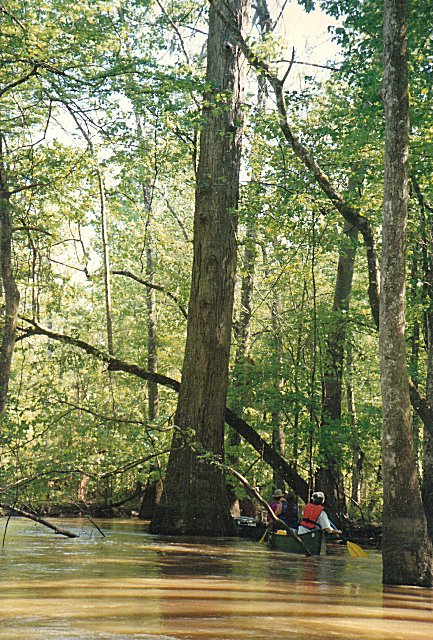
“Most cypress stands today are second growth, but there still remain a few giants among us. They exist because they are hollow and thus not merchantable or because they grow in an area so remote as to make harvest unfeasible. They tower one hundred feet above the earth and laid down their first annular rings during the classical period of the Mayan culture…….
…..They germinated and grew into seedling as Charlemagne was crowned Holy Roman emperor. They were sound and mature when the sun gleamed from the swords of Hernando DeSoto’s men as they marched across northeast Louisiana in a fruitless search for gold……
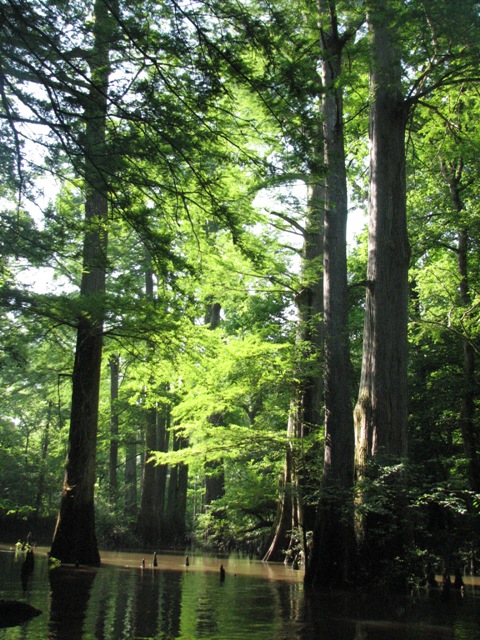
…..It is possible that their limbs were once laden with the weight of a thousand passenger pigeons and that their bark was probed by ivory-billed woodpeckers. Cougars and bears may have sought refuge in their hollows. It is likely that a few of these will still be greeting each spring with a fresh feathering of needle-like leaves in centuries to come” Kelby Ouchley
Here is a 2003- 2024 retrospective of some of the highlights and challenges we've reported on:
2003--
Our LPCL campaign begins. Both the Louisiana House and Senate declare April, 2003 Louisiana Purchase Cypress Legacy month, honoring Louisiana's State tree
The New Orleans Times Picayune covers our kick-off press conference:
FAMILY TREE
Beloved cypress given honor
Volunteers hunting 200-year-old trees
Lynne Jensen
Staff writer
Published: August 20, 2003
The big baldcypress tree in front of Leona Epstein’s Uptown home was marked with a plaque Tuesday because of its historic importance. But it was the mighty presence of the tree that beckoned Epstein in 1959. So taken with the towering cypress was Epstein that she and her husband, Arthur, bought the two-story house it shades at 1664 Robert St. and raised four children there.
"I feel I’m in a treehouse," Epstein said, stepping from her second-floor bedroom onto a porch little more than an arm’s length away from the tree, which measures about 13 feet in circumference. Staring up at the tree from the front lawn were family, neighbors and friends, who gathered for the ceremony marking the cypress as a Louisiana Purchase "Founder’s Tree."
The old tree was alive when renowned pirate Jean Lafitte "was burying his loot," said Harvey Stern, who presented the Epsteins with their Founder’s Tree plaque.
Stern, coordinator of the Louisiana Purchase Cypress Legacy campaign, hopes to identify every baldcypress in Louisiana that is at least 200 years old -- alive at the time of the Louisiana Purchase -- and to ensure that the trees "will grow and prosper without man-made interference" by placing them on a registry of "Louisiana Purchase Trees."
Organizations such as the Sierra Club, the Lake Pontchartrain Basin Foundation and Jean Lafitte National Park are endorsing the volunteer campaign in recognition of this year’s bicentennial of the Louisiana Purchase.
This year marks the 40th anniversary of the designation of the baldcypress as the state tree. The Legislature declared August "Louisiana Purchase Cypress Legacy Month."
The legacy campaign is a treasure hunt for the old trees, which are "as valuable as gold or silver," Stern said.
A Founder’s Tree plaque also was presented Tuesday to Johnny and Mamie Sargent Majoria, who have documented more than a dozen baldcypress trees measuring more than 13 feet in circumference on their 800-acre home site in Harrisonburg.
"The biggest is 23 feet" around, Johnny Majoria said.
The cypress-filled property has been in his wife’s family since 1812, Majoria said. The trees survived the 20th century because his father-in-law, Roy Sargent, who died four years ago at 84, turned a deaf ear to money-waving lumber companies, he said.
"We all have a moral obligation to keep them," Majoria said of the baldcypress trees.
A third plaque was presented to Virginia Rettig, director of the Cat Island National Wildlife Refuge near St. Francisville, home of a bald cypress that is 54 feet in circumference and believed to be between 800 to 1,500 years old.
The Cat Island tree is the largest virgin bald cypress on the planet and the largest tree of any species east of the Sierra Nevada mountains of California, dwarfed in North America only by the giant redwoods and sequoias on the Sierra’s western slope.
The Cat Island tree is the sixth largest tree in the United States and the centerpiece of the 6,500-acre wildlife refuge, Rettig said. "It’s a national treasure right here in Louisiana," she said.
Epstein said the cypress that stands like a giant sentry in front of her home is "a valuable part of our family."
When she bought her house more than 40 years ago, a contractor said the huge tree was too close to the house and should be cut down, Epstein said. "I said, ‘No, the house is too close to the tree,’ " she said. "The house was incidental."
*****
2009
At the Baton Rouge Earth Day Festival last month, the Louisiana Purchase Cypress Legacy display attracted a lot of interest, with several folks eager to tell me of large cypress they know of --some on their own property. The pictures sent by one individual of the cypress on his parents property in Avoyelles Parish were truly astounding—an apparently fully intact giant (not sheared off at the top as most are) that he measured at 12 ½ feet diameter (39.6 feet circumference) at 4 1/2 feet above ground level. If the measurements hold up when I get out to landmark it --and by looks of the pictures they will--, this could very well be the largest cypress tree in Louisiana I’ve come across. Even though it is likely hollow, I hope to get a good enough core to be able to estimate its age. Stay tuned to this Blog for confirmation of circumference, height, and age estimates of this amazing tree!
Other leads of old growth cypress locations I obtained from visitors at the Green festivalincluded sites in St. Tammany, Tangipahoa, and Point Coupee Parishes.
Let me know of any trees you know of that may be two hundred six years or older (alive at the time of the Louisiana Purchase in 1803) and I’d be happy to landmark them (see plaque [at right].
It’s been gratifying to visit all the proud stewards of “LPCL trees” since this campaign started in 2003 (the bicentennial of the Louisiana Purchase), and to commemorate and landmark these centuries old treasures to be found in all corners and backwater sloughs throughout the state.
900+ Year Old Cypress is Landmarked in Avoyelles Parish
2012
Three Rivers WMA Giant Cypress Landmarked in Concordia Parish
Circumference: 35 feet (nine feet above base--above buttress
1st boring: 2.6 inches approx . 94 rings counted
2nd boring 3.8 inches approx 100 rings counted
If corings are reflective of overall growth rate of tree--and taking into account likely faster growth rate of this tree during its earlier growing years (current hollow area)-- it is likely this tree is at least 1500 years old.
This may well be among the very oldest live cypress in the State--it certainly deserves our recognition and protection!
 |
| Location of Three Rivers Giant-- See Inventory for more detail |
*********
Also in 2012, To honor Louisiana's 200th anniversary of statehood, we complemented the La Purchase Cypress Legacy with the Louisiana Bicentennial Cypress Legacy, and awarded plaques to venerable cypress throughout Louisiana, proclaiming them (Alive in 1812". One of the most visited of these is the Monarch Cypress on Bayou Coquille in the Barataria Preserve of Jean Lafitte National Park in Jefferson Parish:
Jean Lafitte National Historical Park and Preserve
News Release
Contact: Aleutia Scott, aleutia_scott@nps.gov, 504-382-7838
Jean Lafitte, Cypress Legacy Honor 700-Year-Old Monarch Tree
MARRERO, LA: Honor “the Monarch of the Swamp” at a special ceremony 10:30 a.m. on Tuesday, June 19, at the Barataria Preserve of Jean Lafitte National Historical Park and Preserve. Representatives of the park, the State of Louisiana, the Louisiana Bicentennial Cypress Legacy, and the Atchafalaya National Heritage Area will mount a plaque near the Monarch, an old-growth baldcypress tree estimated to be about 700 years old. The Monarch is located just off the Bayou Coquille Trail in the preserve, about a quarter mile from the Bayou Coquille Trail parking lot. The preserve is located at 6588 Barataria Blvd. in Marrero (near Crown Point). More information is available at 504-689-3690 ext. 10 or at www.nps.gov/jela.Admission to the ceremony and to the preserve is free and open to the public.
Every Louisiana Bicentennial Cypress Legacy tree must be at least 200 years old and growing in a place currently protected from logging. With the support of the Louisiana Bicentennial Commission, the Louisiana Bicentennial Cypress Legacy (http://www.lapurchasecypresslegacy.net/) works to raise awareness of the value of swamps and the threats to their survival by linking old-growth trees like the Monarch to major events in Louisiana history like this year’s bicentennial of Louisiana statehood. According to Louisiana Bicentennial Cypress Legacy creator Harvey Stern, such landmarks create an ideal opportunity to link Louisiana’s cultural and historic heritage with stewardship of the state’s ecological inheritance.
“Jean Lafitte is honored that ‘the Monarch of the Swamp’ has been chosen as a legacy tree,” said Barataria Preserve Supervisory Park Ranger Aleutia Scott. “The Monarch is well known to the thousands of people who walk the Bayou Coquille Trail every year. It serves as a symbol both of the people and industries who built Louisiana’s past and of new ventures like ecotourism. The Monarch is a reminder that the swamps and wetlands now seen in a few places like the preserve once covered this entire area.”
2013
500+ Year Old Cypress Landmarked on Bayou Dorcheat, Webster Parish, Louisiana

|
| Bayou Dorcheat 500+ year cypress landmarked | |
Bayou Dorcheat is one of the most scenic of Louisiana’s designated Scenic Streams, extending from Lake Bisteneau through Webster parish into Arkansas. Hundreds of old growth cypress line its banks, enriching the timeless sense of wilderness experienced while paddling along this remote stream. The Louisiana Purchase Cypress Legacy landmarked one of these cypress—LPCL Plaque # 38.Here’s what we found out about this representative example of the old growth cypress along Bayou Dorcheat:
GPS coordinates 32 54.837 North 093 23.211 West (on left bank of bayou paddling south)
Circumference (above buttress) 13 feet 4 inch circumference
Diameter: 50 inches Radius: 25 inches
Core sample: 4.5 inches
Rings counted: Approximately 130
Projected age; 500+ years
Projected age of 500+ years takes into account likely faster growing period during early growth period. Like most of these ancient trees the inside is hollow, meaning that core samples reflect slower growing later years.
To view this tree, launch boat at the Hwy 2 access. Paddle south about twenty minutes. Tree is located on left side (east bank) about two minutes paddle before teaching the overhead power lines.. The plaque is not easily visible as you paddle south towards the power lines; however, it will be visible viewed on the right bank heading north about two minutes from the overhead power lines. It is quite a distinctive tree with a full canopy and swirling bark.
We'll be adding this tree to our State wide registry of oldest known trees in each Parish.
If you know of possibly a large/older cypress in Webster Parish please let us know!
2015
Ancient Ascension Parish Giant Landmarked
FOX 8 Dave McNamara's "Heart of Louisiana" Feature story on La. Purchase Cypress Legacy:
https://www.fox8live.com/story/30484500/heart-of-louisiana-legacy-cypress/
Our quest to find the largest/oldest cypress in each Parish recently took us to the Martin lake vicinity of Ascension Parish, where Terry Matherne took us to view a beautiful old cypress he found on his property, located between Lake Martin and the Amite river.
This was truly an impressive cypress.
Here are the stats: Circumference: Approximately 21’10 “ (where the trunk meets the buttress)
Diameter 6’11” Radius 3’ 5.5”
1st coring 2.75” rings counted: 100+
2nd coring 2.5” rings counted: 60+

Projected age: 700—1000 years This is a conservative estimate; if very close spacing of rings were to hold up through the entire radius, this tree would be well over 1000 years old. However, it is likely that the tree grew faster (with rings correspondingly further apart) in its early years and "adolescence". Coring samples are from later growth periods
You can follow our trek to this beautiful tree and learn more about our efforts to identify and landmark old growth cypress throughout Louisiana by linking to David McNamara's recent Fox 8 "Heart of Louisiana" series feature on the Louisiana Purchase Cypress Legacy here: http://www.fox8live.com/story/30484500/heart-of-louisiana-legacy-cypress
This is now the oldest documented live cypress in Ascension Parish and was awarded LPCL Plaque #45. As a proud owner of this tree and of several other old growth specimens nearby, Terry Mathern's intent to leave his property in its natural state exemplifies the stewardship of our natural heritage that can be found throughout Louisiana.
Know of any cypress that may be larger/older in Ascension or in other Parishes throughout the state? Let us know at LaPurchaseCypressLegacy@gmail.com
2018
St. Landry Parish's Two Oldest Known Cypress Identified
 |
The "Cathedral Tree" near Washington LA.

 |
Many thanks to Mr. and Mrs Larry Lieux for taking me to this beautiful old cypress that they've christened the "Cathedral Cypress". According to Larry, the tree is located on several hundred undeveloped acres of land known as Kops and Kids, which is leased for hunters and maintained by St. Landry Sherrif Bobby Guidroz. The Lieux's and friends ride horses on this heavily wooded property, and discovered this tree several years ago while on on of there horseback rides.
Last November we took a rollicking ride on the Lieux's Honda Big Red ATV on muddy, rutted paths to the site of the tree on Bayou Corron.
Here's what we found
Cathederal Tree, (Lieux) St. Landry
GPS N30 37.113 W092 04.448
Circumference 24' at buttress (6.5 feet above ground), estimated 19' trunk
72 inch diameter, 36 inch radius
boring: 2.75 inches -- approx rings counted: 51
51 rings/x = 2.75(boring)/36(radius)
x=667 rings
PROJECTED AGE: APPROX 500-550 YEARS OLD (This estimate accounts for the likely faster growing rate doing the tree's early years--the part of the tree that is now hollow)Cathederal Tree,
 |
Cathedral Cypress:
Tightly spaced rings indicative of a very old slow growing
cypress--approximately 51 counted on this boring
*********************
Ancient Cypress Landmarked on Bayou Jack in St Landry Parish
 |
 |
| This Bayou Jack Tree maintains a 24'+ trunk to the full upper canopy |
Bayou Jack, St. Landry Parish
GPS N30 50.778 W091 52.042
Circumference: 24’6’’ (trunk—6 ft above base)
 |
| Location on Bayou Jack in extreme NE St. Landry Parish northwest of Melville, just below Avoyelles Parish Line |
This tree (and several nearby ones) certainly rivals the Cathedral Tree near Washington as the
oldest known cypress in St. Landry Parish. Although I was unable to to get a boring of the tree, it's 24 ft. trunk circumference certainly would make it at least as old as the Cathedral (At least 500 years old) As with the Cathedral cypress and many similarly sited LPCL landmarked cypress , this is likely a very slow growing cypress. It has been landmarked with Plaque #42. Many thanks to Mr Rabelais for location information. This and the Cathedral Tree are prime examples of statewide (if not national) natural treasures hiding in plain site, but which could not have been landmarked without the
help of hunters, landowners and others who tell us where to find them!
********************
The LPCL documents old growth cypress in path of proposed Keystone pipeline through the Atchafalaya Basin:
Bayou Bridge Pipeline Faces Mounting Legal Challenges in Louisiana

By
Julie DermanskyonJan 21, 2018 @ 03:07 PST
Series:
BAYOU BRIDGE PIPELINE BATTLE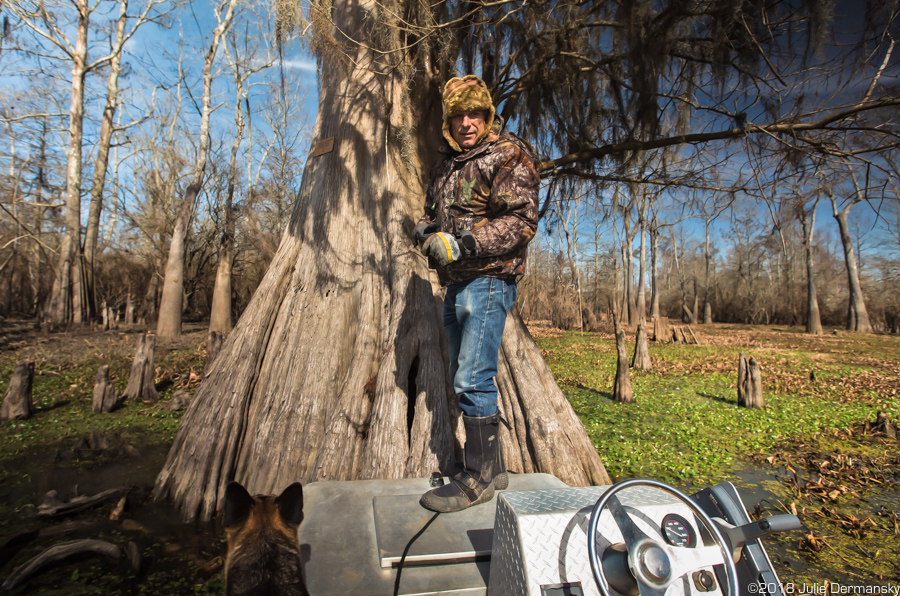
Though Energy Transfer Partners has all the permits and permissions it needs to start work on the Bayou Bridge pipeline, the project still faces multiple legal challenges.
The 162-mile pipeline, being built by the same company behind the
Dakota Access pipeline, will span southern Louisiana from Lake Charles, near the Texas border, to St. James, about 60 miles west of New Orleans. This route will cut through the Atchafalaya Basin, a national heritage area that contains America’s largest swamp.
“If the Bayou Bridge pipeline is built, a 75-foot-wide swath of trees will be pulverized,” Dean Wilson, executive director of the
Atchafalaya Basinkeeper, told me, pointing to markers that surveyors recently put up along the pipeline route. The markers gave me a clearer picture of what will be lost if the pipeline is built.
Louisiana’s Legacy Trees
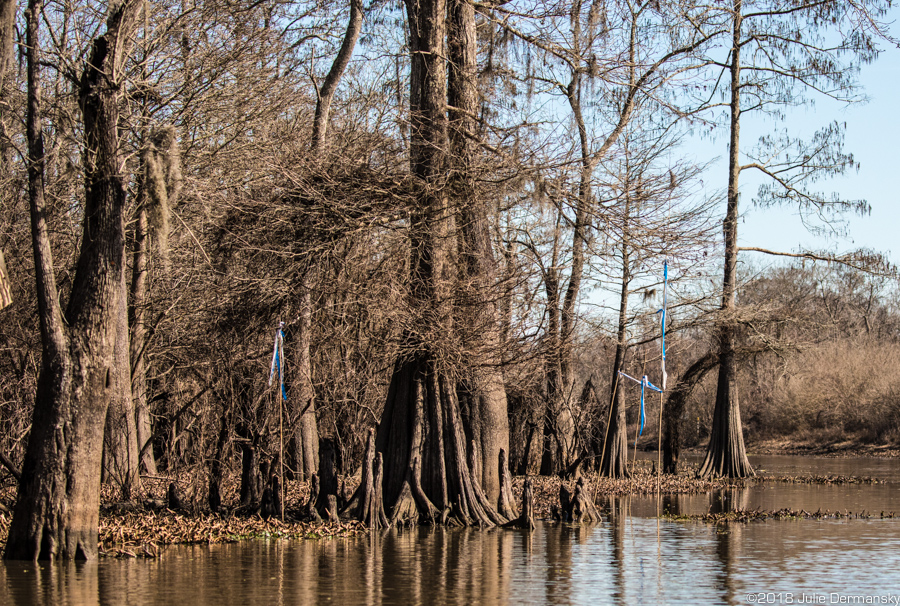
Markers tied along the route of the Bayou Bridge pipeline in the Atchafalaya Basin.
On January 15, I joined Wilson on a trip into the basin where he took Sierra Club Atchafalaya Committee Chair Harvey Stern, who is also coordinator of the
Louisiana Purchase Cypress Legacy blog that identifies Louisiana’s old growth trees, and a group of activists opposed to the pipeline. The trip’s mission was to give Stern a chance to take core samples to determine the age of some of the cypress trees in the pipeline route’s path. This information could be used in the legal battle to stop the pipeline.
Stern will use the core samples and measurements of the trees’ girths to calculate the approximate age of the trees. He classifies “legacy trees” as those which were alive before 1803, when the U.S. made the Louisiana Purchase.
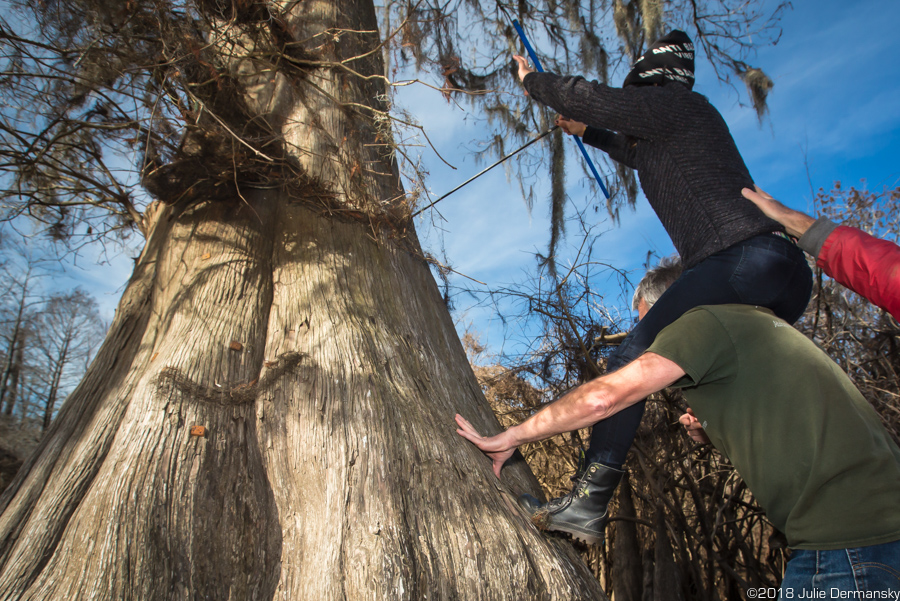
Team effort by Yudith Nieto, organizer
with Another Gulf Is Possible, Dean Wilson, and Harvey Stern to take a core sample from a cypress tree.
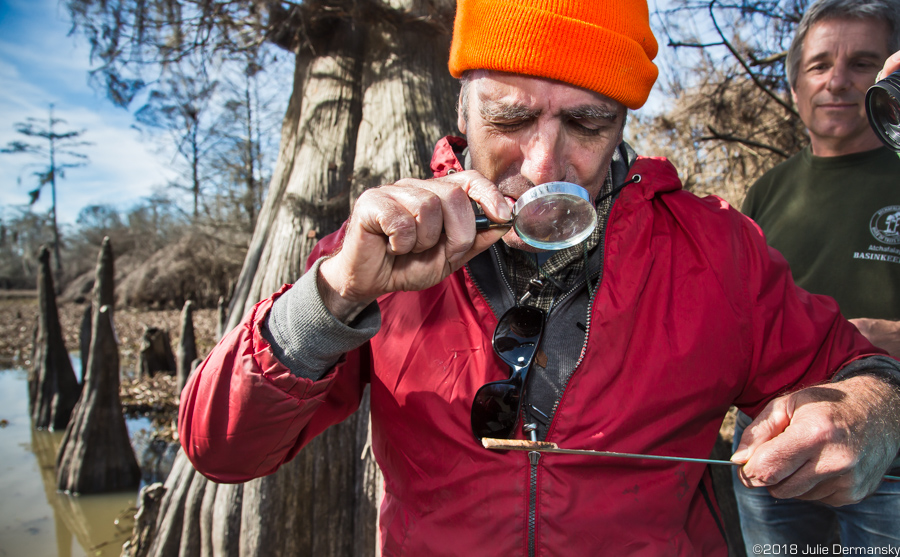
Harvey Stern examining a core sample taken from a hollow cypress tree in the Atchafalaya Basin.
It troubles Stern that there is no count of the old growth cypress in the basin that would be sacrificed if the pipeline were built. Though Louisiana’s old-growth cypress
forests are all but gone, there are still numerous trees well over 200 years old that Stern believes are worth protecting.
Wilson and Stern assert that if the pipeline had an environmental impact statement (EIS) done, it would likely have to consider the number of old growth trees destroyed and the role they play in the basin’s ecosystem.
An EIS is required by the
National Environmental Policy Act for actions that significantly affect the quality of the environment, and is used as a tool for federal agencies to assess the environmental effects of their proposed actions prior to making decisions. In this case, however, the U.S. Army Corps of Engineers didn’t deem an EIS necessary for this project, and granted a permit to Energy Transfer Partners without one.
“A project of this magnitude will certainly impact the basin,” Wilson said, “and the state needed to take such factors into account before permits were granted.” The absence of an EIS is a point of contention for the Atchafalaya Basinkeeper, the Waterkeeper Alliance, Gulf Restoration Network, and the Louisiana Crawfish Producers Association, which are working with Earthjustice to reverse the Army Corps of Engineers’ decision to grant a permit.
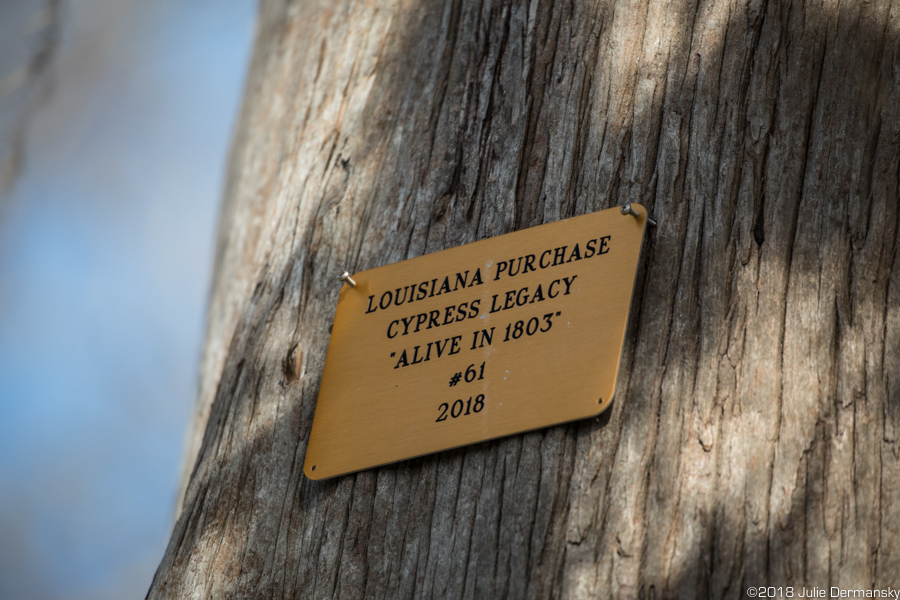
Cypress tree with a legacy marker in the Atchafalaya Basin.
Bayou Bridge Lawsuits Pile up
Earthjustice, a law firm committed to protecting the environment, filed a federal suit on January 7 calling for the court to repeal the permit awarded by the Army Corps. The lawsuit alleges that the government failed to consider irreparable harm to the Atchafalaya River Basin when it approved the oil pipeline.
A Basin Already Affected
The Atchafalaya Basinkeeper’s Wilson hopes the challenges to the pipeline will serve as a wake-up call to everyone, including the governor, about the environmental damage existing pipelines have already caused in the basin, and the need for regulators to hold pipeline operators accountable for that damage.
Water flow is being hindered by spoil banks created when many of the pipelines already in the basin were first installed. Instead of filling in the trenches dug for their pipelines, non-compliant operators left piles of dirt lining their routes. Installing yet another pipeline underneath one of these spoil banks will make their removal close to impossible, and could further hinder natural water flow in the basin, which will impact crawfishing.
On our tour of the basin, as we pulled up to one giant hollow cypress bearing a plaque identifying it as a legacy tree, a beaver huddled inside the tree scurried away. Wilson explained the old-growth cypresses that remain are, for the most part, hollow. They are the only trees that had no value to loggers, who ended up sparing them. Aside from being majestic icons for the state, these hollow trees are of great value to otters, raccoons, black bears, minks, and squirrels. One reason, Wilson said, is that when the area floods, the hollow cypress act like a Noah’s Ark for the animals.
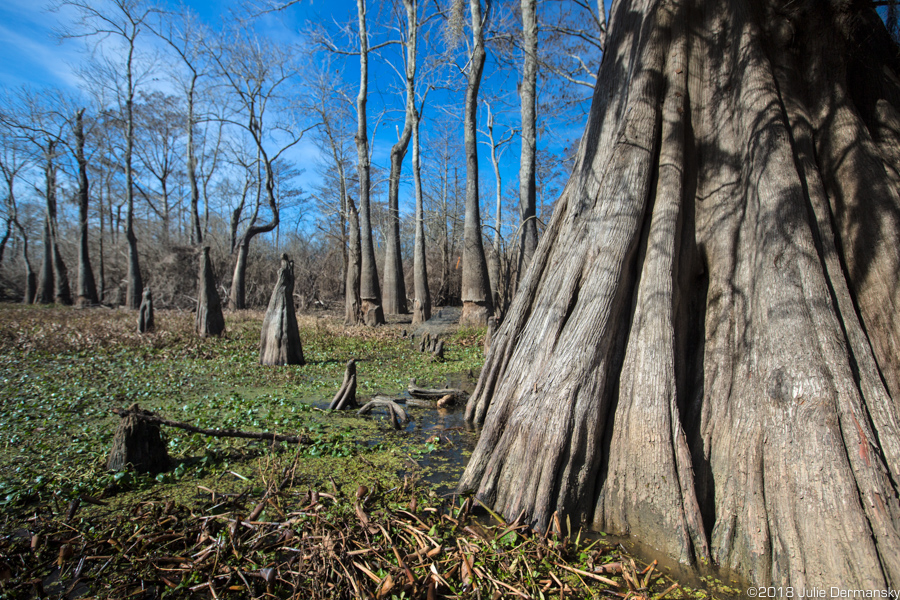
Cypress tree in the Atchafalaya Basin that is slated to be cut down along the Bayou Bridge pipeline’s proposed route.
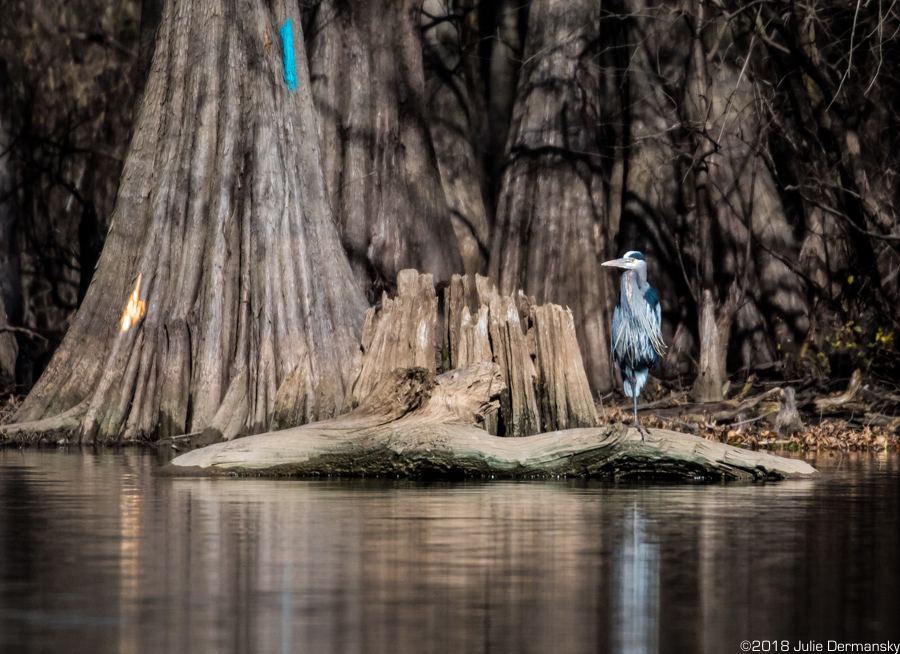
Great blue heron in the Atchafalaya Basin.
Can Energy Transfer Partners start building the pipeline before all of these cases are settled? The answer is yes, but the plaintiffs can seek an injunction. Wilson wouldn’t comment on what the coalition challenging the federal permit might do if pipeline construction starts before the suits are settled, but it was clear to me the fight against this pipeline is far from over.
2019


This 39” diameter (above buttress) cypress on private land along Bayou Bodcau was landmarked by John Michael Kelley in 2018. John Michael, a resident of Boissier Parish, has been volunteering with the La. Purchase Cypress Legacy, avidly landmarking old growth cypress in the Bayou Bodcau vicinity, as well as finding old growth remnant forests in Northwest Louisiana for inclusion in the Old Growth Forest Network (https://www.oldgrowthforest.net/louisiana)
Based on a 9 inch coring and 39 inch diameter ( 10.2 feet circumference above buttress), John Michael estimated 350 total rings to the hollowed out center and is conservatively estimating the age at 275 + years. John Michael awarded this cypress LPCL Plaque # 67 ("Alive in 1803")
(While the adjacent tree was larger and older, it was also quite decayed.)
Local paddlers have taken notice of this landmarked cypress; as seen in the photos below the Bayou Bodcau watershed is a treasure trove of remnant old growth cypress. Efforts are underway to promote Bayou Bodcau as an old growth paddle trail
 |
| N 32.69295 W 93.54618 (center pin) below Bodcau dam Plaque #64 |
 |
The "Zac Burson" Tree-- Plaque #26 |
2021
Hardwater Lake in Grant Parish a Treasure Trove of Old Growth Cypress
As promised in an earlier post, we will be adding locations throughout Louisiana where significant stands of old growth are accessible. One of favorite areas to explore is Hardware Lake in Grant Parish. Hundreds of old growth cypress are within easy paddling distance of the boat launch, including the grizzly old one we awarded Plaque #73--- many of which are likely several centuries old. The link below takes you to a map showing you the GPS location and a photo of the cypress at that location.
Hardwater Lake Map of Old Growth Cypress























































